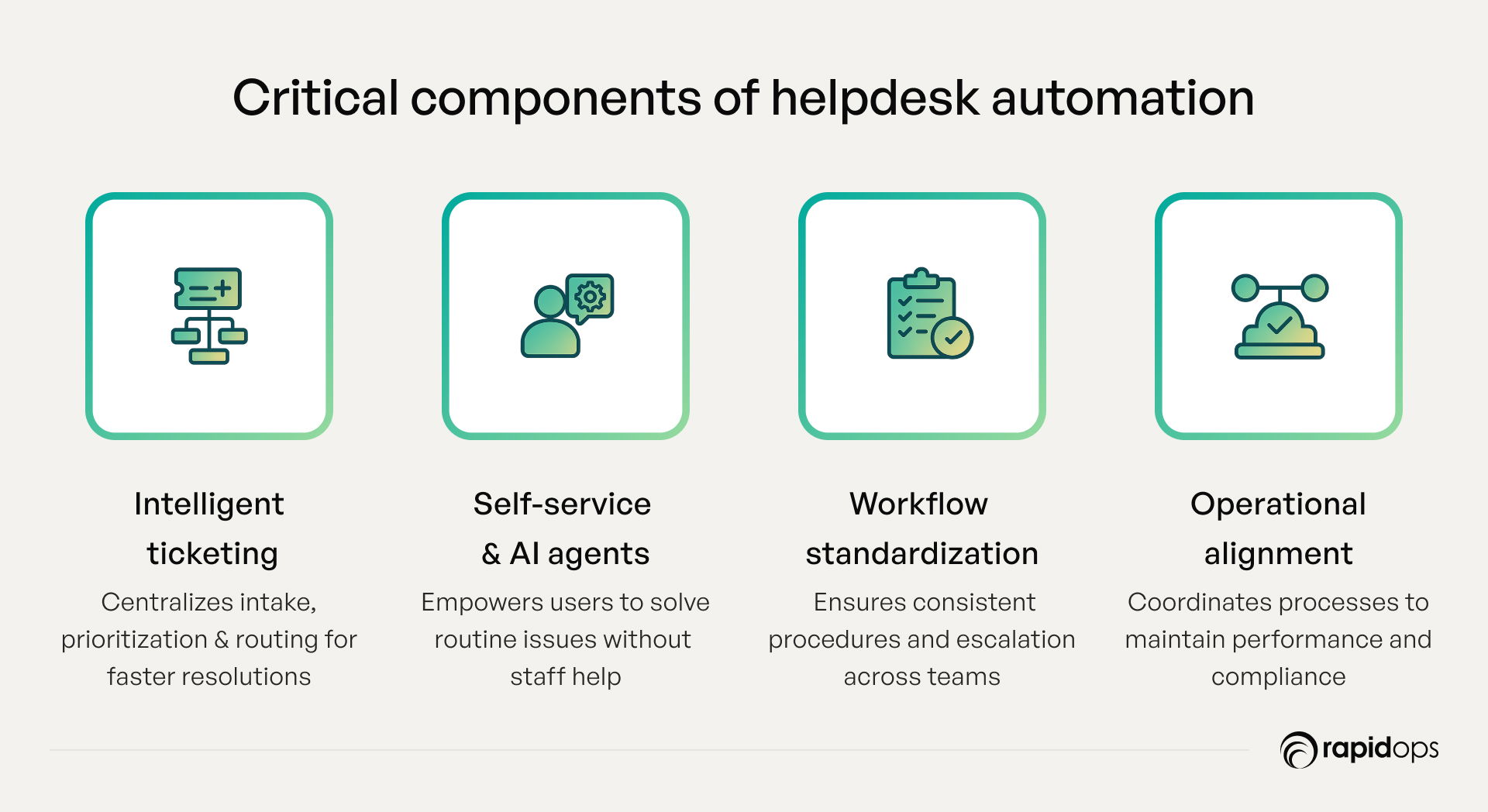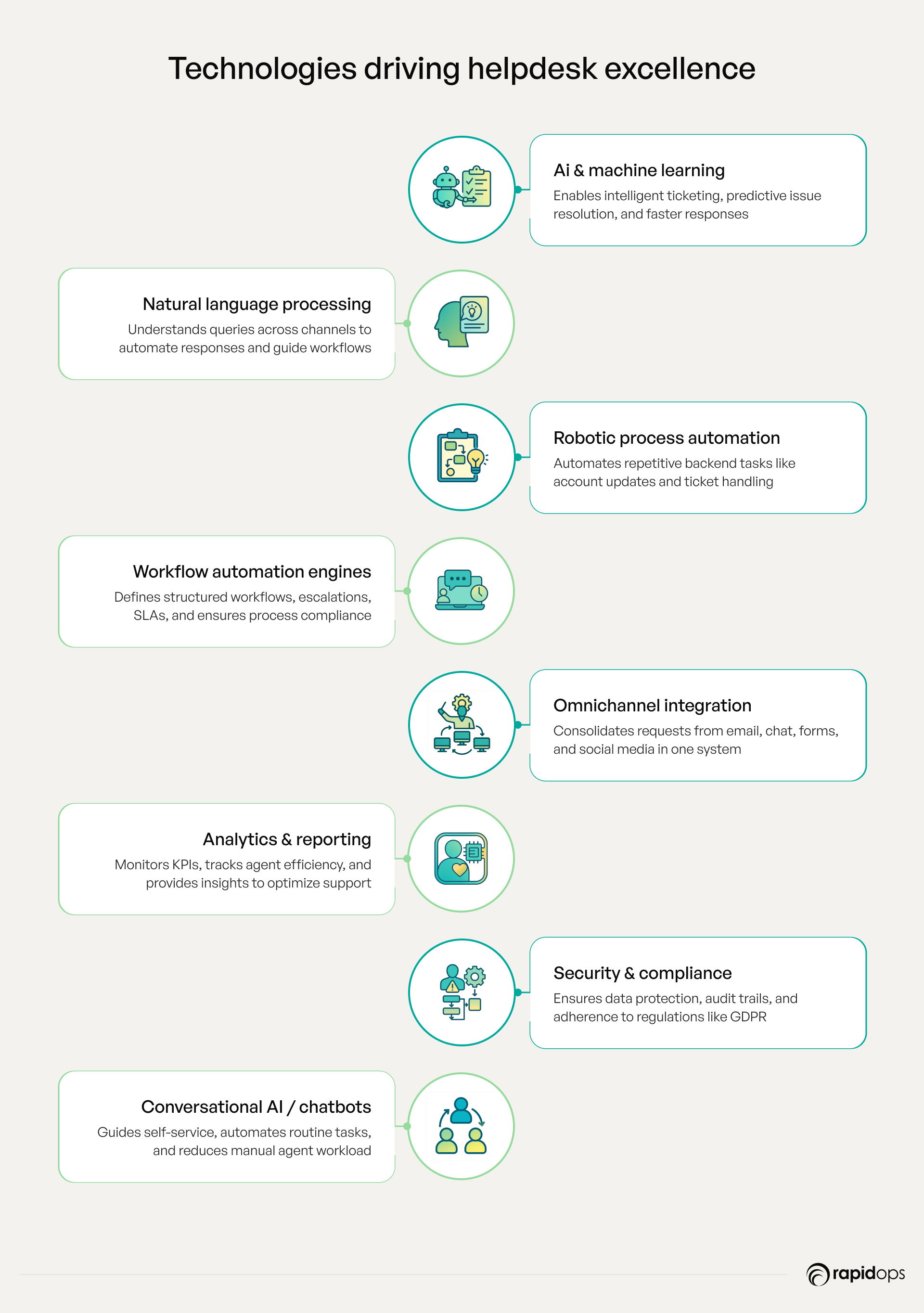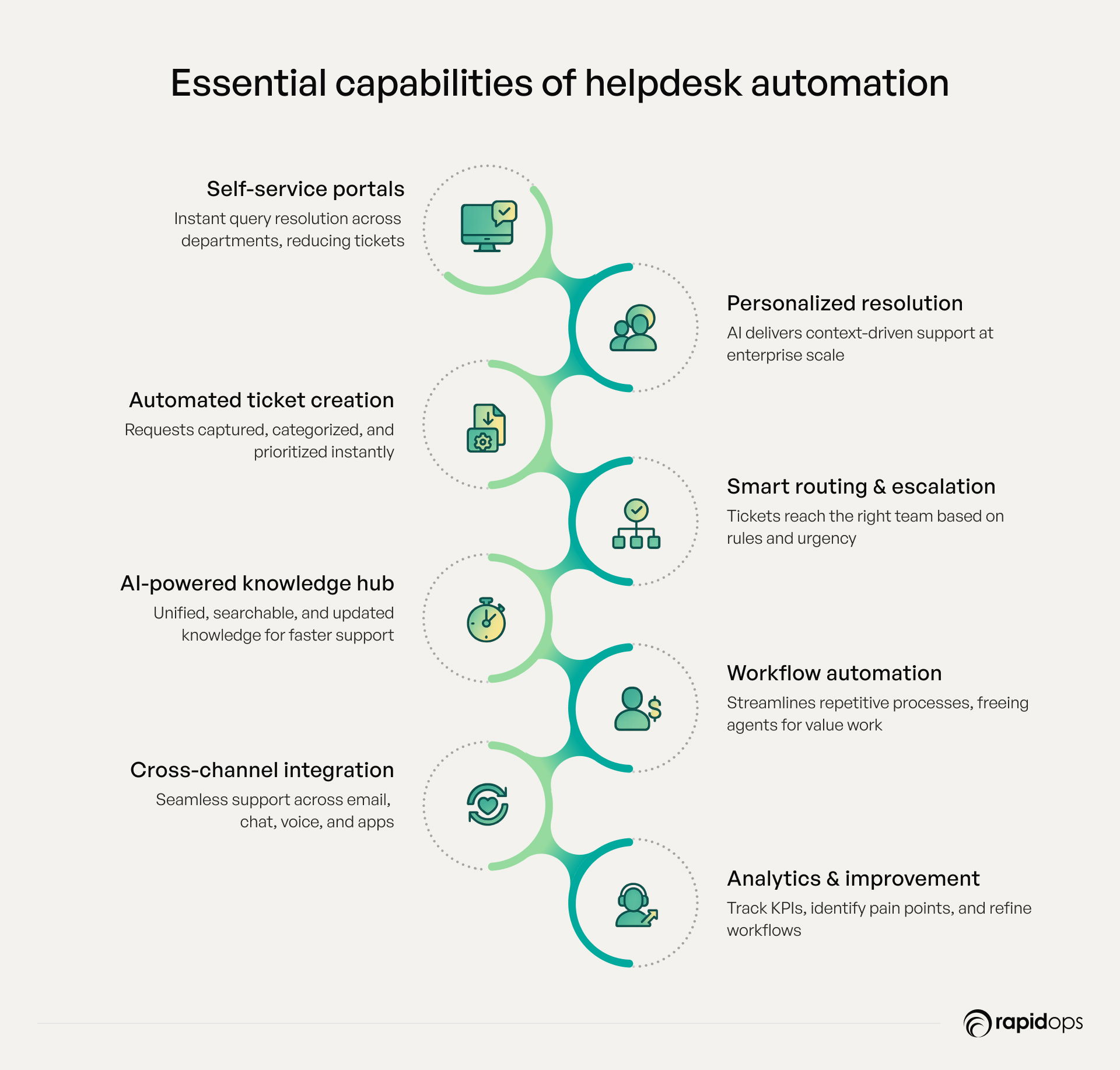Every day, support teams manage hundreds, sometimes thousands, of similar customer queries, and research shows that up to 70% of these queries are repetitive, encompassing a range of issues, from password resets to order updates. These interactions may appear routine, but collectively they drain valuable time, slow response rates, and prevent teams from focusing on complex, high-value needs that truly differentiate and optimize the customer experience.
The financial burden is just as clear. Support costs continue to rise 5–10% annually, driven by growing ticket volumes and escalating resource demands. Efforts to control these costs often come at a price: longer wait times, slower resolutions, and frustrated customers. It’s a trade-off many businesses know too well.
If this tension feels familiar, you’re not alone. Now imagine a support operation where these repetitive queries are resolved automatically or through self-service, allowing your team to focus on meaningful, high-impact interactions that strengthen customer loyalty and fuel growth.
This blog explores how enterprises can reimagine their support operations to enhance efficiency, reduce costs, and eliminate recurring pain points, all while maintaining customer satisfaction. By the end, you’ll see how shifting from reactive firefighting to proactive, intelligent processes can turn operational pressure into a sustainable advantage.
What is helpdesk automation
Helpdesk automation is the strategic application of intelligent technologies, AI, and structured workflows to transform enterprise support operations. It automates repetitive tasks such as password resets, account updates, and routine service requests, ensuring they are handled consistently, accurately, and at a scale.
Beyond being a technology deployment, helpdesk automation represents a systematic approach to operational efficiency, allowing support teams to focus on complex, high-value work while routine interactions are managed automatically. This creates a scalable, reliable, and consistent support framework that can maintain service quality even as request volumes grow, aligning support operations with broader enterprise goals.
By understanding helpdesk automation in this way, leaders gain a strategic perspective on how automation not only improves day-to-day efficiency but also strengthens enterprise resilience, enhances operational agility, and enables better allocation of human and technological resources across the organization.
Core components and functional scope
In complex enterprises, support teams often face overwhelming ticket volumes and fragmented workflows. Helpdesk automation addresses this by organizing operations into core components and structured processes, providing leaders with clarity on how efficiency, consistency, and measurable outcomes are achieved across departments.

Key components include:
- Intelligent ticket management: Centralizes ticket intake, categorization, prioritization, and routing to ensure requests are addressed accurately and promptly.
- Self-service & virtual agents: Enable users to resolve routine inquiries through guided knowledge bases and virtual assistants, minimizing dependency on support staff.
- Workflow standardization: Implements consistent escalation paths, resolution procedures, and knowledge updates across departments, ensuring uniform service quality.
- Operational alignment: Coordinates processes across the enterprise to maintain high performance, compliance, and measurable support outcomes.
These components collectively define the functional scope of helpdesk automation, emphasizing how the system operates across the enterprise to enhance reliability, efficiency, and service consistency, without delving into the underlying technologies themselves.
Key technologies powering helpdesk automation
Helpdesk automation relies on a combination of intelligent technologies and platforms that work together to streamline enterprise support operations, reduce manual effort, and enhance service quality. Understanding these technologies helps leaders grasp how automation delivers measurable business value.

Key technologies include:
- Artificial intelligence (AI) & machine learning (ML): Power intelligent ticket categorization, prioritization, and predictive issue resolution, enabling faster and more accurate responses.
- Natural language processing (NLP): Analyzes customer queries from emails, chat, and social media, understanding intent and context to automate responses and guide workflows.
- Robotic process automation (RPA): Automates repetitive backend tasks such as account updates, password resets, and ticket status updates across multiple systems.
- Workflow & process automation engines: Define structured workflows, escalation rules, SLAs, and approvals, ensuring consistency and compliance in ticket handling.
- Omnichannel integration platforms: Consolidate requests from email, chat, web forms, and social media into a unified system for seamless handling.
- Analytics & reporting tools: Provide real-time dashboards, KPIs, and trend analysis to monitor performance, track agent efficiency, and optimize processes.
- Security & compliance frameworks: Include SSO, audit trails, and adherence to GDPR/HIPAA regulations to ensure secure and compliant support operations.
By combining these technologies, helpdesk automation transforms traditional support systems into intelligent, proactive, and scalable operations, freeing human agents to focus on complex, high-value tasks while ensuring consistent, accurate, and timely responses.
Why are traditional helpdesks falling behind in 2025
In 2025, enterprises face unprecedented volumes of support requests, rising customer expectations, and growing operational complexity. Traditional helpdesks, built on manual workflows and legacy systems, are struggling to meet these demands. The limitations are multifaceted and directly impact service quality, operational efficiency, and strategic agility.

1. Manual processes slow resolution
Traditional support relies on human intervention for ticket intake, categorization, routing, and approval. Each manual step introduces delays and increases the likelihood of errors. In high-volume environments, this slows response times, reduces throughput, and creates bottlenecks that hinder operational efficiency.
2. Inconsistent support quality
Without standardized processes or automated validation, responses vary by agent, team, or department. This inconsistency leads to errors, miscommunication, and uneven user experiences. Maintaining quality becomes increasingly challenging as the organization scales, undermining trust in the support function.
3. Scaling challenges with growing demand
As enterprises expand, ticket volumes rise exponentially. Traditional helpdesks struggle to scale without proportional increases in staff, resulting in high operational overhead, strained resources, and delays during peak demand periods. Scaling manually is neither cost-efficient nor sustainable.
4. Limited access to knowledge and self-service
Legacy helpdesk systems often lack integrated knowledge bases, contextual guidance, or self-service portals. Employees and customers are forced to submit tickets for routine inquiries, consuming valuable agent time and extending resolution cycles. The absence of easily accessible information prevents proactive issue resolution and slows the support ecosystem.
5. SLA compliance risks
Manual routing, prioritization, and escalation processes increase the likelihood of missed deadlines and SLA breaches. Inconsistent tracking and reporting further exacerbate the risk, potentially leading to contractual penalties, reputational damage, and strained relationships with clients or employees.
6. Frustrated customers and delayed service
The combination of slow response times, inconsistent quality, and limited proactive support has a direct impact on the user experience. Frustrated customers or employees are more likely to escalate issues, repeat inquiries, or disengage, which increases workload and amplifies operational pressure.
7. Overburdened support teams
Support agents are often consumed by repetitive, low-value tasks, leaving insufficient capacity to handle complex or strategic issues. Overload leads to decreased productivity, higher burnout rates, and a workforce less able to deliver critical insights or improve processes.
8. Outdated technology and integration gaps
Legacy helpdesk platforms frequently lack real-time analytics, AI capabilities, or integration with enterprise systems. These limitations prevent the automation of routine workflows, reduce visibility into ticket trends, and hinder the ability to proactively identify and address issues or optimize operations.
9. Rising operational costs
Inefficiencies, high manual effort, and scaling challenges directly translate to rising support costs. Enterprises face increasing expenditure on staffing, overtime, and error resolution, creating a constant tension between controlling costs and maintaining service quality.
10. Competitive disadvantage without automation
Organizations that fail to modernize support operations are at a strategic disadvantage. Competitors leveraging intelligent automation, self-service platforms, and integrated knowledge systems can provide faster, more reliable, and cost-efficient support, gaining a clear edge in customer experience, operational agility, and market reputation.
What’s driving the need for helpdesk automation in 2025
Support teams are stretched to their limits, managing a flood of repetitive tickets while customers expect instant, flawless service. Rising operational costs, overburdened employees, and intensifying competitive pressures create daily tension. These pressures are converging to drive an urgent shift toward helpdesk automation, highlighting the forces shaping modern enterprise support.

1. Escalating support volumes
Digital transformation and the proliferation of service channels have driven an exponential increase in support requests. Research indicates that support ticket volumes grow by 15–20% annually in mid-to-large enterprises, creating operational strain and potential backlogs. Automation allows organizations to handle high volumes efficiently without proportionally increasing headcount, ensuring responsiveness and operational continuity.
2. Pressure for faster resolution
Modern customers expect near-instant responses, and delayed resolutions can erode trust and loyalty. Enterprises relying on manual workflows often struggle to meet these expectations, resulting in SLA breaches and prolonged resolution times. Automation accelerates ticket routing, prioritization, and resolution, reducing average response times while maintaining quality.
3. Operational inefficiencies
Manual ticket handling, repetitive tasks, and fragmented support systems create inefficiencies that directly impact productivity and costs. Studies suggest support teams spend up to 60% of their time on repetitive, low-value activities. Hyperautomation standardizes workflows, minimizes errors, and streamlines processes, allowing teams to focus on high-value tasks that drive business impact.
4. Employee productivity and engagement challenges
Support agents often spend excessive time on routine queries, leaving limited bandwidth for problem-solving or strategic initiatives. This can lead to fatigue, lower engagement, and increased attrition rates. By automating repetitive tasks, organizations free employees to focus on complex issues, improving productivity, satisfaction, and retention.
5. Scalability requirements
Enterprises must scale support operations dynamically to accommodate business growth, seasonal spikes, or global expansion. Traditional helpdesks require significant manual effort to scale, increasing costs and operational risk. Automation offers a flexible and adaptive framework that can handle fluctuating demand while maintaining high service quality.
6. Need for consistent customer experience
Inconsistent service delivery across channels, departments, or geographies undermines customer trust. Automation enforces standardized workflows, knowledge-driven responses, and adherence to policies, ensuring a consistent, high-quality experience for every interaction.
7. Proactive and predictive support expectations
Customers and employees increasingly expect proactive guidance. AI-powered alerts and predictive insights enable organizations to anticipate issues before they escalate. Automation supports predictive ticketing, proactive notifications, and issue prevention, reducing friction and improving satisfaction.
8. Competitive and strategic pressure
Support operations have become a key differentiator. Companies that leverage automation gain faster, more accurate, and cost-efficient service delivery, while those that lag risk losing market share, customer loyalty, and operational agility. Automation is no longer optional; it is essential for sustaining competitive advantage.
What are the core capabilities of helpdesk automation
Support teams spend nearly 40% of their time on repetitive tasks, time that could be redirected to solving real customer problems. The core capabilities of helpdesk automation directly address this gap. From intelligent ticket routing to proactive issue resolution, they redefine how enterprises scale support while improving quality and speed.

1. Self-service portals across departments
Automation begins with intuitive self-service portals that allow employees and customers to resolve everyday queries instantly. From resetting passwords and checking payroll to accessing policy documents or requesting approvals, users can bypass manual intervention and find answers in seconds. This reduces ticket volumes, increases efficiency, and fosters a culture of independence.
2. Personalized resolution at scale
AI ensures support isn’t just faster, it’s smarter. With context-driven routing, issues are automatically directed to the right team, while integrated knowledge bases surface relevant solutions in real time. Predictive analytics can even anticipate repeat issues, helping teams resolve them before they affect more users. The result: resolutions tailored to individual needs, delivered at enterprise scale.
3. Automated ticket creation and categorization
Manual ticket logging is replaced by automated capture and categorization. Whether requests come through email, chat, or voice, automation instantly translates them into structured tickets, tags them by issue type, and sets the right priority. This eliminates delays and ensures no request gets overlooked.
4. Intelligent routing and escalation
Not every ticket is the same, and automation ensures the right ones reach the right people. Intelligent routing and escalation assign tasks based on expertise, workload, or urgency, while rule-based workflows escalate unresolved issues. This ensures efficiency while protecting service-level commitments.
5. AI-driven knowledge management
Support agents and end users alike benefit from AI-powered knowledge systems that unify documentation, FAQs, and guides across departments. Searchable, context-aware, and continuously updated, these systems ensure everyone has instant access to the right information, reducing duplicate efforts and accelerating learning.
6. Workflow automation
Repetitive, time-consuming processes, such as approvals, notifications, updates, or back-office tasks, are streamlined through workflow automation. By orchestrating these steps in the background, helpdesks reduce human error and free up staff for higher-value problem-solving.
7. Cross-channel integration
Today’s users expect consistent support across email, chat, mobile apps, and voice. Omnichannel integration connects these touchpoints into a single, unified platform, allowing for seamless transitions without losing context. Whether a user starts on chat and moves to email, the conversation continues smoothly.
8. Analytics and continuous improvement
Ultimately, automation provides comprehensive visibility into performance, trends, and user experience. Leaders can track KPIs like first-contact resolution, agent efficiency, and request volumes while identifying emerging pain points. These insights enable the continuous refinement of workflows, ensuring the helpdesk evolves in line with business needs.
What are the key benefits of helpdesk automation for enterprises
Helpdesk automation delivers strategic value across operational, financial, and customer experience dimensions. By embedding intelligence, scalability, and proactive workflows, enterprises can transform support operations from a reactive function into a competitive advantage. The following benefits demonstrate how automation drives measurable impact for executives and business leaders.

1. Faster ticket resolution
AI-powered automation can reduce ticket resolution time by up to 70%, significantly accelerating response and issue closure. Instant ticket creation, intelligent routing, and prioritization ensure inquiries reach the right agent immediately. For executives, this enhances SLA compliance, fosters customer trust, and mitigates revenue risk associated with delayed service, allowing support teams to concentrate on strategic, high-impact initiatives.
2. Higher operational efficiency
AI-enabled agents can handle up to 30% more inquiries per hour without additional staffing by automating repetitive tasks and streamlining workflows. AI-driven chatbots can handle up to 80% of routine inquiries, freeing human agents to focus on more complex issues. Additionally, 37% of organizations equip their customer service agents with AI tools to enhance performance, further improving operational efficiency.
3. Consistent service quality
Automation ensures uniform customer responses 24/7, improving trust and adherence to SLAs. Standardized workflows, knowledge-driven guidance, and policy enforcement guarantee consistent experiences across channels, geographies, and departments. For leadership, this reduces variability in service delivery and reinforces brand reliability.
4. Improved employee productivity
AI tools enhance employee performance by up to 40%. By offloading repetitive queries, employees can focus on high-value tasks, problem-solving, and strategic initiatives. This reduces fatigue, increases engagement, and lowers attrition, strengthening operational stability while fostering a more motivated workforce.
5. 24/7 support availability
By 2025, 80% of customer service organizations are expected to deploy AI chatbots for round-the-clock support. Automation ensures uninterrupted service for global customers and internal teams, maintaining responsiveness without significant staffing costs. Continuous availability enhances satisfaction, loyalty, and operational resilience.
6. Proactive issue prevention
Predictive analytics and AI-powered alerts can reduce incident frequency by up to 30% (McKinsey). By identifying potential issues before they escalate, enterprises prevent downtime, mitigate operational risks, and improve reliability. Executives benefit from reduced disruption and greater confidence in operational continuity.
7. Scalable support operations
AI enables handling 5–10 times increases in ticket volumes without proportional cost increases (Deloitte AI Reports). Automated systems adapt to growth, seasonal spikes, and geographic expansion, maintaining consistent service quality. Scalability ensures enterprises are future-ready and capable of sustaining high operational performance under any demand scenario.
8. Reduced operational costs
Helpdesk automation lowers support costs by up to 30% through intelligent triaging and workflow optimization. Reduced manual effort, faster resolution, and improved workforce allocation enable enterprises to reinvest resources in strategic initiatives, driving both short-term savings and long-term competitiveness.
9. Enhanced customer satisfaction
AI-driven support improves CSAT by 20–25% through faster responses, personalization, and proactive resolution. Higher satisfaction fosters loyalty, repeat business, and a stronger brand reputation. Leaders can measure tangible business impact via retention rates and customer lifetime value.
How enterprises leverage helpdesk automation efficiently
Enterprises leverage helpdesk automation efficiently by embedding it exactly where support bottlenecks occur. From intelligent ticket routing that instantly connects issues to the right experts, to automated follow-ups and integrated systems that give teams full visibility, every step is designed for precision. This section outlines concrete strategies to implement automation workflows that accelerate resolution, optimize team resources, and transform routine support operations into a streamlined, high-impact system.
1. IT Services: Intelligent ticket management
Monday morning arrives, and your IT team is already navigating a flood of support requests, password resets, system errors, and access issues, while SLAs loom and employees across hybrid and global offices grow impatient. The sheer volume can overwhelm even the most skilled teams, leaving little room for strategic initiatives.
AI-driven ticket triage, routing, and escalation transforms this scenario. Each request is automatically classified, prioritized, and assigned to the right team. Critical issues are escalated instantly, ensuring nothing is delayed, while repetitive tasks are automated, freeing your IT professionals to focus on complex, high-value projects.
The impact is tangible: tickets are resolved faster, SLA compliance improves, operational stress decreases, and the IT workforce is empowered to contribute strategically rather than reactively. Beyond efficiency, leadership gains a proactive IT function that elevates end-user satisfaction, strengthens employee engagement, and positions technology as a key driver of business growth.
2. Retail: Streamlined returns and order support
Imagine a customer receiving a product that doesn’t meet expectations, only to reach out for a return or refund and face delays and confusion due to manual processing. Frustration builds, not just for the customer, but also for support teams struggling to keep up with repetitive inquiries.
Automated workflows for returns processing, combined with AI-driven customer guidance, transform this experience. Requests are instantly logged, processed, and tracked, while AI chatbots guide customers step-by-step through returns or order queries, reducing reliance on human intervention for routine cases.
The results are immediate and measurable: response times drop, errors in processing are minimized, operational efficiency rises, and customer satisfaction improves. Employees are freed from repetitive tasks, allowing focus on complex cases and strategic initiatives. Retailers gain a frictionless support operation that boosts loyalty, strengthens brand reputation, and scales effortlessly with growing demand.
3. Manufacturing: Equipment and IT support automation
In manufacturing, even minor equipment failures or IT disruptions can ripple across production lines, causing shipment delays, missed deadlines, and operational bottlenecks. Support teams often work reactively, diagnosing issues under pressure, juggling fragmented data, and coordinating across departments, which leads to inefficiencies and escalating costs.
Helpdesk automation addresses these challenges head-on. Predictive ticketing identifies potential machine or IT failures before they occur, while automated incident reporting captures and categorizes problems in real time. Proactive alerts notify relevant teams instantly, and AI-guided diagnostics offer step-by-step resolution instructions or trigger computerized fixes. This reduces reliance on manual intervention and ensures issues are addressed at the earliest possible stage.
By integrating predictive intelligence, automation transforms support from a reactive, fragmented process into a coordinated, proactive system. Teams gain clarity on potential bottlenecks, streamline workflows, and resolve critical problems more quickly, turning complex operational challenges into manageable and predictable processes.
4. Distribution: Vendor and partner support automation
In distribution, managing vendor and partner interactions manually can create operational friction. Support teams spend hours handling repetitive requests, verifying invoices, and checking compliance, often across multiple systems. These inefficiencies slow response times, increase errors, and strain relationships with critical partners.
Helpdesk automation streamlines these processes with AI-driven workflows. Vendor inquiries are automatically captured, categorized, and routed to the right team. Invoice approvals, compliance verifications, and document tracking are handled seamlessly within the system, reducing manual intervention and ensuring accuracy. Real-time alerts notify stakeholders of pending tasks, while integrated dashboards provide visibility across the vendor ecosystem.
By embedding intelligent automation, organizations transform complex, manual processes into smooth, predictable operations. Teams gain clarity, reduce administrative overhead, and can focus on strategic partner management, ensuring that vendor interactions support operational continuity and business growth.
What makes helpdesk automation implementation difficult
Implementing helpdesk automation is a transformative step for enterprises, but it comes with inherent complexities that require careful planning and strategic oversight. Understanding these challenges enables organizations to anticipate obstacles, make informed decisions, and ensure smoother adoption across departments.

1. Resistance to change
Adoption often faces pushback from employees accustomed to traditional workflows. Change can create uncertainty, fear of job displacement, or skepticism toward new technology. This resistance can slow implementation timelines, reduce engagement, and limit the effectiveness of automation initiatives. Leaders must address cultural and behavioral factors to secure team buy-in.
2. Integration complexity
Enterprises typically rely on multiple legacy systems, ERP platforms, and communication tools. Integrating helpdesk automation with these disparate systems can be technically challenging, as it requires careful mapping of workflows, APIs, and data exchange. Poor integration can lead to fragmented operations and reduced operational efficiency.
3. Data quality and consistency
Automation relies on accurate, structured, and clean data. Inconsistent ticket histories, incomplete customer information, or fragmented knowledge bases can compromise the performance of AI-driven workflows and self-service systems. Decision-makers must ensure data governance practices are in place before implementation.
4. Skill gaps
Implementing and maintaining advanced automation platforms requires specialized expertise in AI, machine learning, workflow design, and system administration. Organizations lacking these capabilities may face delays, operational errors, or reliance on external consultants, which can impact both project efficiency and cost.
5. Finding the right technology partner
Even with internal skills, implementation can stall without a partner who understands the enterprise’s workflows and integration needs. Selecting a technology partner aligned with operational goals and scalability requirements ensures smoother deployment, faster adoption, and minimal disruption, helping organizations overcome common automation hurdles effectively.
6. Security and compliance concerns
Handling sensitive customer and internal data through automated workflows raises compliance, privacy, and cybersecurity considerations. Enterprises must ensure the platform adheres to regulatory standards (such as GDPR, HIPAA) and implements robust security protocols to protect data integrity and avoid potential legal exposure.
7. Customization vs. standardization
Enterprises often struggle between leveraging out-of-the-box automation capabilities and tailoring workflows to unique business requirements. Excessive customization can increase complexity, costs, and maintenance effort, while rigid standardization may limit operational flexibility and user adoption.
8. Measuring ROI
Quantifying the benefits of helpdesk automation can be challenging due to its indirect impacts, such as improved customer satisfaction and increased employee productivity. Without clear metrics, leaders may struggle to justify ongoing investment or evaluate performance improvements, potentially stalling broader adoption.
9. Maintaining employee engagement
Automation can shift roles, reassign responsibilities, or reduce repetitive tasks. Without careful change management, employees may feel disconnected or undervalued, leading to disengagement. Maintaining engagement is crucial to ensure smooth adoption, effective knowledge sharing, and the leveraging of human expertise in high-value areas.
Transforming support into strategic advantage
Modern enterprise support is evolving rapidly, and organizations that rely on manual workflows risk inefficiency, frustrated employees, and a decline in customer trust. Helpdesk automation transforms these challenges into strategic opportunities, streamlining operations, accelerating resolutions, and enabling teams to focus on value-driven initiatives.
At Rapidops, we’ve partnered with enterprises across industries to implement AI-driven helpdesk solutions that directly address operational bottlenecks. By aligning automation with business processes, we’ve helped leaders reduce repetitive workloads, maintain SLA compliance, and empower teams to act proactively, turning support into a measurable driver of operational performance and strategic growth.
Want to know how to automate your helpdesk and unlock next-level efficiency? Schedule a call with our automation expert to explore solutions tailored for your enterprise.
Frequently Asked Questions
How can helpdesk automation reduce operational costs?
Helpdesk automation lowers operational costs by streamlining ticket handling, reducing manual workflows, and optimizing workforce allocation. AI-driven ticket triage and routing decrease response times, minimize errors, and cut labor requirements, allowing teams to focus on high-value tasks. Enterprises can achieve up to 30% cost savings while improving SLA compliance, operational efficiency, and customer satisfaction, turning support operations into a lean, scalable, and strategic function.
What industries benefit most from helpdesk automation?
Industries with high-volume customer interactions or complex internal operations reap the greatest benefits from helpdesk automation. Retail, manufacturing, finance, healthcare, and IT services see improved operational efficiency, faster ticket resolution, and enhanced employee productivity. Enterprises with global operations benefit from multi-lingual support and 24/7 automated services, while high-compliance sectors leverage automated workflows to maintain regulatory standards, reduce errors, and increase scalability.
What role does AI play in helpdesk automation?
AI powers intelligent ticket triage, predictive issue resolution, and knowledge-based recommendations in helpdesk automation. Machine learning identifies patterns, predicts potential incidents, and automates repetitive tasks, enabling faster responses and proactive support. For executives, AI enhances decision-making by providing actionable insights, optimizing workforce utilization, and ensuring consistent service quality, turning customer support into a strategic differentiator for operational efficiency and competitive advantage.
How do chatbots and virtual assistants enhance helpdesk automation?
Chatbots and virtual assistants provide instant, 24/7 responses to routine queries, reducing ticket volumes and freeing human agents for complex tasks. By integrating AI-driven understanding, these tools personalize interactions, guide users to solutions, and proactively resolve issues. Enterprises benefit from lower response times, improved customer satisfaction, and operational scalability, while decision-makers gain insights into common inquiries, trending issues, and workflow optimization opportunities.
How do automated systems ensure personalized customer experiences?
Automated helpdesk systems leverage AI to analyze customer history, preferences, and interaction patterns. Personalized responses, context-aware recommendations, and predictive assistance ensure every interaction is relevant and timely. Enterprises can maintain consistent, high-quality experiences across channels while boosting satisfaction, loyalty, and retention. Decision-makers benefit from actionable insights that guide strategy, optimize agent performance, and tailor workflows for maximum business impact.
How secure is helpdesk automation in handling sensitive customer data?
Modern helpdesk automation platforms integrate advanced security protocols, including end-to-end encryption, role-based access, and compliance with regulations such as GDPR and HIPAA. AI-driven monitoring detects anomalies, while automated logging ensures audit readiness. For enterprises, this guarantees data integrity, mitigates risks of breaches, and strengthens trust with customers and partners, enabling secure operational efficiency without compromising regulatory compliance.
Can businesses customize automated helpdesk solutions to suit their unique needs?
Yes. Enterprises can tailor workflows, ticket routing rules, knowledge bases, and reporting dashboards to align with business processes, customer segments, and industry requirements. Customizable solutions balance standardization with flexibility, enabling organizations to scale efficiently, maintain SLA compliance, and deliver personalized service. Leaders can prioritize high-value tasks, optimize staffing, and adapt quickly to evolving operational and market needs.
How does helpdesk automation support multi-channel customer service?
Automated platforms integrate email, chat, phone, social media, and enterprise portals, providing a unified view of all interactions. AI-driven routing ensures inquiries reach the right agents, while self-service portals and chatbots maintain responsiveness across channels. Enterprises achieve consistent service quality, faster resolutions, and reduced duplication, empowering decision-makers to monitor performance metrics and optimize multi-channel support strategies seamlessly.
What are the key features to look for in helpdesk automation software?
Critical features include AI-driven ticket triage, intelligent routing, predictive analytics, knowledge management, multi-channel support, self-service portals, workflow automation, scalability, security, and robust reporting. Enterprises should prioritize platforms that integrate seamlessly with existing systems, provide actionable insights, and allow customization to align with business objectives. These features ensure operational efficiency, improve customer satisfaction, and strategic decision-making capabilities.

Rahul Chaudhary
Content Writer
With 5 years of experience in AI, software, and digital transformation, I’m passionate about making complex concepts easy to understand and apply. I create content that speaks to business leaders, offering practical, data-driven solutions that help you tackle real challenges and make informed decisions that drive growth.
What’s Inside
- What is helpdesk automation
- Core components and functional scope
- Key technologies powering helpdesk automation
- Why are traditional helpdesks falling behind in 2025
- What’s driving the need for helpdesk automation in 2025
- What are the core capabilities of helpdesk automation
- What are the key benefits of helpdesk automation for enterprises
- How enterprises leverage helpdesk automation efficiently
- What makes helpdesk automation implementation difficult
- Transforming support into strategic advantage

Let’s build the next big thing!
Share your ideas and vision with us to explore your digital opportunities
Similar Stories
- AI
- 4 Mins
- September 2022

- AI
- 9 Mins
- January 2023


Receive articles like this in your mailbox
Sign up to get weekly insights & inspiration in your inbox.

